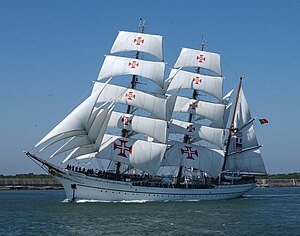NRP Sagres III

The Portuguese Navy school ship Sagres under full sail
|
|
| History | |
|---|---|
|
|
|
| Name: | Albert Leo Schlageter |
| Namesake: | Albert Leo Schlageter |
| Builder: | |
| Launched: | 1937 |
| Fate: | Seized as war reparation by the United States |
|
|
|
| Acquired: | 1944 |
| Fate: | Sold to the Brazilian Navy |
|
|
|
| Name: | Guanabara |
| Acquired: | 1948 |
| Fate: | Sold to Portuguese Navy |
|
|
|
| Name: | NRP Sagres |
| Acquired: | 1961 |
| Status: | Training ship |
| General characteristics | |
| Type: | Barque |
| Displacement: | 1,755 long tons (1,783 t) |
| Length: | 89 m (292 ft 0 in) o/a |
| Beam: | 12 m (39 ft 4 in) |
| Draught: | 5.2 m (17 ft 1 in) |
| Sail plan: | 2,000 m2 (22,000 sq ft) sail area |
| Speed: | 17 knots (31 km/h; 20 mph) |
The NRP Sagres is a tall ship and school ship of the Portuguese Navy since 1961. As the third ship with this name in the Portuguese Navy, she is sometimes referred to as Sagres III.
The ship is a steel-built three masted barque, with square sails on the fore and main masts and gaff rigging on the mizzen mast. Her main mast rises 42 m (138 ft) above the deck. She carries 22 sails totaling about 2,000 m2 (22,000 sq ft) and can reach a top speed of 17 kn (31 km/h; 20 mph) under sail. She has a sparred length of 89 m (292 ft), a width of 12 m (39 ft), a draught of 5.2 m (17 ft), and a displacement at full load of 1,755 long tons (1,966 short tons).
The three-masted ship was launched under the name Albert Leo Schlageter on 30 October 1937 at Blohm & Voss in Hamburg for Nazi Germany's Kriegsmarine. The ship was named after Albert Leo Schlageter, who was executed in 1923 by French forces occupying the Ruhr area. Her first commander was Bernhard Rogge. Sagres is a sister ship of the Gorch Fock, the Horst Wessel, and the Romanian training vessel Mircea. Another sister, Herbert Norkus, was not completed, while Gorch Fock II was built in 1958 by the Germans to replace the ships lost after the war.
Following a number of international training voyages, the ship was used as a stationary office ship after the outbreak of World War II and was only put into ocean-going service again in 1944 in the Baltic Sea. On 14 November 1944 she hit a Soviet mine off Sassnitz and had to be towed to port in Swinemünde. Eventually transferred to Flensburg, she was taken over there by the Allies when the war ended and finally confiscated by the United States.
...
Wikipedia
